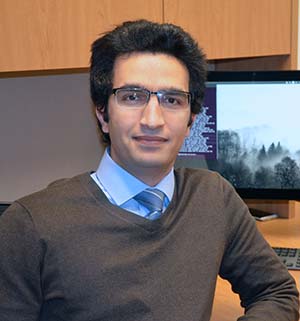
Pejman Tahmasebi, an assistant professor in the University of Wyoming's College of Engineering and Applied Science, is this year's Arie van Weelden Award winner.
"I am extremely honored by this award, which reflects all of the research accomplished during my past positions as a Ph.D. student, a postdoc and also at UW," says Tahmasebi, who works in the UW Department of Petroleum Engineering. "I appreciate the support I received from my mentors, students at UW and my family. I do not look at this award as a prize, but as a reason to excel in our research and address more long-standing and major problems related to geoscience and geomaterials."
Dennis Coon, interim head of the UW Department of Petroleum Engineering, praises Tahmasebi's award.
"Tahmasebi is an energetic, creative and very productive faculty member. This award is a recognition that Tahmasebi's innovative research has a significant impact on the geosciences field," Coon says. "I congratulate Tahmasebi on his award and am certain that he has a very bright future in the field."
The Arie van Weelden Award is presented to a member of the European Association of Geoscientists and Engineers (EAGE) who has made a highly significant contribution to one or more of the disciplines in the association -- and who qualifies as an EAGE young professional (a geoscientist or engineer aged 35 or below) at the time of the nomination. EAGE is a leading international organization honoring excellence in geoscience and geophysics.
The van Weelden Award consists of a medal and a certificate as well as a cash prize equal to 1,000 euros.
Among his many scientific achievements, Tahmasebi is recognized for his outstanding work in several major fields: description of large-scale porous media, stochastic modeling of (sub)surface systems, machine learning and the problem of reconstruction of a 3D model from a 2D slice.
Developing what is now called cross-correlation-based statistical simulation, Tahmasebi's method produces highly accurate realizations of the geosystems that honor the available data and provide predictions for those properties for which no data are used in constructing the model. The computations are fast, and the memory requirements are modest. This work is frequently cited and widely used, and the results were published in Physical Review Letters.
In addition, Tahmasebi has developed a solution to the classical reconstruction problem: Given a single 2D slice image of a 3D porous medium, is it possible to produce a 3D model for the whole medium? Tahmasebi has shown his method works in a wide variety of systems, including brain images, a human lung, a river delta and granular packing of particles.
"The research we currently are conducting is in the intersection of various fields of science and engineering," Tahmasebi says. "This makes our research more important and, at the same time, challenging. However, we are actively working on the problems that matter and can help our society. Thus, we are extensively working on fundamental unknowns and finding solutions for such problems. This is truly enjoyable and rewarding when you can see that the results of your research are used and recognized."
For his excellent research work, Tahmasebi received the 2017 Andrei Borisovich Vistelius Research Award from the International Association for Mathematical Geosciences.
Tahmasebi came to UW in 2016. He has published three book chapters and has led or contributed to 82 scholarly papers published in research journals. He received his Ph.D. from the University of Southern California and then attended Stanford University, the University of Texas-Austin and the California Institute of Technology as a research scientist.






